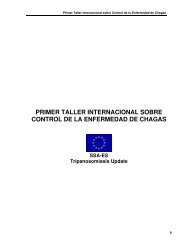El uso de Sistemas de Información Geográfica - CDIA-EC ...
El uso de Sistemas de Información Geográfica - CDIA-EC ...
El uso de Sistemas de Información Geográfica - CDIA-EC ...
Create successful ePaper yourself
Turn your PDF publications into a flip-book with our unique Google optimized e-Paper software.
<strong>El</strong> <strong>uso</strong> <strong>de</strong> <strong>Sistemas</strong> <strong>de</strong> <strong>Información</strong> Geografica y Sensores Remotos (SR) en Salud Pública<br />
Bogotá, Colombia, 27 al 30 <strong>de</strong> Marzo <strong>de</strong> 2006<br />
triatomines and it can help to i<strong>de</strong>ntify the specific characteristics of houses that<br />
should be prioritized in house improvement programmes.<br />
The results from two risk factor analysis are presented here: 1) from a controlled<br />
research study carried in Barinas (South-Western Venezuela) and 2) from an<br />
unusually large survey carried out by a team of four Colombian institutions in<br />
conjunction with Ministry of Health Personnel.<br />
A multivariate logistic regression was un<strong>de</strong>rtaken to i<strong>de</strong>ntify risk factors (35<br />
measured at house level and 18 at outbuilding level) for indoor triatomine<br />
infestation and colonisation in 18 villages (552 houses and 1,068 peridomestic<br />
outbuildings) in Barinas State, Venezuela. All houses and peridomestic outbuildings<br />
were inspected by active search ai<strong>de</strong>d with tetramethrin and by househol<strong>de</strong>rs, who<br />
were urged to keep any triatomines found. After adjusting for other risk factors,<br />
including palm roofs and the presence of hen nests, R. prolixus infestation and<br />
colonisation of outbuildings (and, to some extent, houses) was significantly<br />
associated with proximity to high <strong>de</strong>nsities of Attalea butyracea palm trees. House<br />
infestation was also positively associated with bug <strong>de</strong>nsity in peridomestic<br />
outbuildings, the age of the palm roof, the presence of pigsties and hen nests. The<br />
presence of cement walls and electricity resulted protective factors for infestation<br />
and colonization with R. prolixus respectively. House infestation and colonization<br />
with Triatoma maculata was significantly enhanced in houses with hen nests<br />
present. Amongst peridomestic outbuildings with nests, the highest risks of<br />
infestation and colonization were in outbuildings with a palm roof.<br />
In Colombia the association between triatomine infestation and housing<br />
characteristics was investigated based on an unusually large standardized survey<br />
in 41,971 houses in 15 <strong>de</strong>partments. Multivariate logistic regression was used to<br />
test for associations of two highly correlated infestation measures of infestation<br />
(househol<strong>de</strong>rs reporting having seen triatomines insi<strong>de</strong> the house, and sending<br />
triatomines to the survey team), with 15 household level risk factors. Resi<strong>de</strong>nts<br />
were asked if they had seen triatomines and were han<strong>de</strong>d posts to collect any<br />
triatomine they would find. The results from house-level risk factor analysis in<br />
58




